Welcome!!
Originally published in 2016 and in a constant state of revision!! ©
Egyptologists assert that the arrangement of chambers within the Great Pyramid reflects King Khufu’s indecisiveness, suggesting it lacks any deliberate design. However, they often overlook several key observations: the King’s Chamber shows signs of scorching and discoloration, the Queen’s Chamber has an accumulation of salt—up to an inch and a half thick—on its walls, and the Subterranean Chamber may exhibit evidence of water erosion and cavitation, rather than being merely unfinished. These phenomena could be explained by heat being concentrated in the King’s Chamber, an electrochemical process occurring in the Queen’s Chamber, and water-hammer effects in the Subterranean Chamber.

Fire In The Middle
By Danny Kerr
Hypothetically, high-amplitude sound waves are generated within the Great Pyramid through thermoacoustic means, producing and sustaining a monotone note. Water hammer is utilized for timing, driving a piston, creating pressure, and generating steam in the upper chambers. Water was likely pumped to the pyramid’s apex and allowed to percolate downward through the stone. Electricity could be generated by converting heat into sound, and then sound into electricity via the piezoelectric response of quartz present in the granite. In this scenario, the King’s Chamber functions as a large transducer.
The granite blocks do not plug the First Ascending Passage tightly; there is space around them. Both the ascending passage and the granite blocks show signs of wear and tear on the limestone. The First Ascending Passage narrows where it meets the Descending Passage, creating the illusion that the granite blocks are sealing it. If a shockwave of water surged up the Descending Passage, the granite blocks would be propelled upward along the Ascending Passage. Acting as pistons, these blocks would compress any gases within the pyramid while also forcing water into the upper chambers. Furthermore, when submerged in water, the granite blocks’ effective density would decrease from 2.5 g/cm³ (their actual density) to approximately 1.5 g/cm³, making them significantly lighter due to buoyancy.
John Cadman, an American hydrologist, has been reverse-engineering the Subterranean Chamber of the Great Pyramid for years, continually uncovering new insights into its design. He has demonstrated that water drains freely through the chamber and that the shafts connected to it are engineered to reflect and contain a compression wave, or water hammer. Here’s a video of John describing his pulse-generator model:
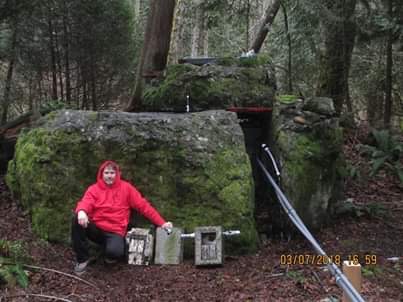
In ancient times, the Pyramids of Egypt were surrounded by perimeter walls that Egyptologists claim were intended to deter thieves. However, John Cadman argues that these perimeter walls were very likely designed to contain water.
The ram pump within the Great Pyramid does not require the percolation shaft to operate.
The cycle of the ram pump in the Great Pyramid is estimated to occur approximately once every 1.75 to 2 seconds and would deliver roughly 20 to 30 megawatts of input power per pulse, not accounting for losses.
The function of the Queen’s Chamber
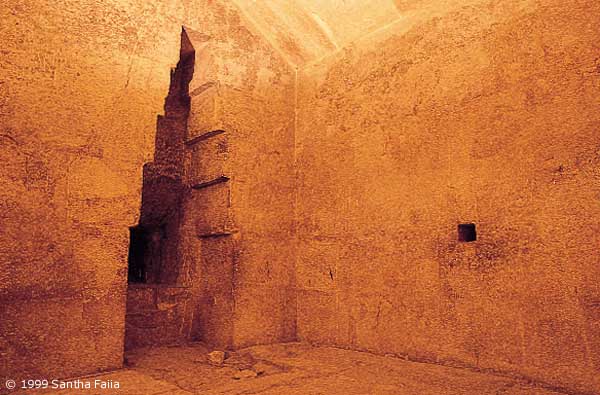
The Queen’s Chamber once had salt encrusted on its walls and ceiling, reaching up to 3.75 cm (1.5 inches) thick. Two small shafts leading into the chamber were each blocked by a limestone block with a crack running through it. The chamber has since been cleaned, exposing the underlying limestone, and the limestone blocking the shafts was chiseled away during searches for treasure. From the shafts, archaeologists recovered a piece of copper shaped like a dual hook, a small piece of wood, and a stone ball, which are now on display at a British museum. Subsequent inspections using pipe inspection cameras revealed that the shafts are blocked by limestone blocks featuring two copper handles, or electrodes. It appears that these shafts monitored fluid levels via a fluid switch that opened or closed a circuit.
The Earth possesses a natural negative charge, while the ionosphere maintains a natural positive charge. The Pyramid builders appear to have exploited this potential difference for electrolysis production by constructing the Great Pyramid—and specifically the King’s Chamber vents—high in the air to draw in the ionosphere’s natural positive charge. Consider the Queen’s Chamber as a negative electrode, characterized by the salt buildup on its surfaces. In this scenario, the King’s Chamber would serve as the positive electrode. Hydrogen would be generated at the Queen’s Chamber, and oxygen at the King’s Chamber. If the King’s Chamber vents were sealed in ancient times, I believe the King’s Chamber would function as the cathode, with the Queen’s Chamber acting as the anode, or collection point, in a configuration resembling a vacuum tube.
According to Chris Dunn’s book, The Giza Power Plant, in 1978, researcher Patrick Flanagan analyzed the salt from the Queen’s Chamber and found it to contain a mixture of calcium carbonate, sodium chloride, and calcium sulfate.
The Queen’s Chamber may have served a straightforward function: the salt coating its surfaces could have been intentionally allowed to accumulate to mix with incoming water. Its role might have been to increase the total dissolved solids in the water entering the upper chambers. Since the Nile is freshwater, its electrical conductivity (EC) is relatively low; adding salt would enhance the water’s electrical conductivity, making it more effective for splitting and combusting. Adding salt to water also lowers its freezing point, which may permit a thermoacoustic cooling process.
Here’s a video demonstrating how radio frequencies can split saltwater and ignite the resulting gases into a constant flame. In this video, a lazy yellow flame is produced, indicating unburnt fuel. The inventor, John Kanzius, was researching a cure for cancer when he inadvertently discovered a method to essentially set fire to water.
A series of experiments conducted at Penn State University’s Microwave Lab used test tubes of water with salinity levels ranging from 0.1% to 30%. At just 3% salinity, the phenomenon shown in John Kanzius’ YouTube video of burning water was confirmed. The radio frequency used to split the water, as described in the link above, is 13.56 MHz at 300 watts of power. It is hypothesized that the King’s Chamber generates a radio frequency of 14.3 MHz at a power of up to 20 megawatts, feeding that signal back into the Pyramid’s chambers. The acoustic resonance of the King’s Chamber is believed to stimulate standing waves of piezoelectric charge within the electromagnetic spectrum. The strongest axial mode of the King’s Chamber, from its east-to-west walls, is estimated to be 14.3 MHz. Signal reference: http://www.bigskymap.com/cotp/CYCLESr24.pdf
The Thermoacoustic Regenerative Pulsejet
Pulsejet engines have few or no moving parts, only require ignition upon startup, and are very loud. https://en.wikipedia.org/wiki/Pulsejet
Valveless Pulsejet Test 7-11-2010
The dimensions and flatness of the Great Pyramid’s internal chambers and passages appear carefully designed to tune and operate as a pulsejet (thermoacoustic) style engine, generating heat and sound within the King’s Chamber and Grand Gallery. This system uses the resonance and heat to sustain vibrations throughout the pyramid. A pulsejet engine aligns remarkably well with this pyramid power model: pulsejets produce high sound pressure levels, significant thrust, and substantial heat, requiring minimal maintenance. Fire could be continuously generated through the combination of fuel, oxygen, and heat, potentially eliminating the need for a spark to initiate combustion. The slanted Grand Gallery would facilitate the direction of heat and the mixing of gases. Hydrogen, being lighter, would rise from the bottom to the top of the gallery, while oxygen, being heavier, would sink from the top to the bottom. With the Earth’s and ionosphere’s natural, cost-free electric charge harnessed to generate gases, and cost-free water hammer driving the process, we may be observing the world’s largest, slowest-working, cost-free-energy pulsejet, intricately connected to the wheelworks of nature. I believe this concept would have made Nikola Tesla proud; according to Tesla, his greatest achievement was the installation of the world’s first hydroelectric alternating current power station at Niagara Falls.
The Pulsejet nature of the Great Pyramid may be better described as a Pulse Detonation Engine. https://en.wikipedia.org/wiki/Pulse_detonation_engine
A ram pump can also be integrated with a trompe, a water-powered air compressor. Such a system could provide both timing and compressed air for an engine.
https://en.wikipedia.org/wiki/Trompe
Here’s a video demonstrating a combination ram pump trompe.
https://www.youtube.com/watch?v=xv1lQA-tnwo
It’s also possible that the pulsejet function within the Great Pyramid operated without any combustion occurring. If steam permeated the device, that alone might be sufficient for the pulsejet to function. Here’s a link to a 1975 patent for a heat engine in the form of a water pulsejet, which bears a striking resemblance to the system observed inside the Great Pyramid:
https://patentimages.storage.googleapis.com/ac/67/b6/eeccf9baab69d5/US3898800.pdf
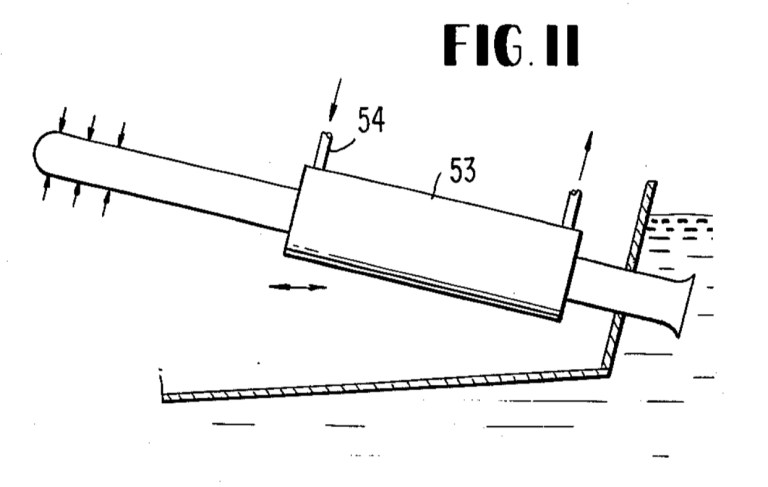
The acoustic input from the ram pump should generate piezoelectricity, which would add heat to the King’s Chamber, raising its temperature above that of the Grand Gallery. By equalizing the volumes of the King’s Chamber and the Grand Gallery—achieved by filling the Grand Gallery one-third of the way with water—and containing heat in the King’s Chamber, creating a choke point between the two chambers at approximately one-quarter the length of the system, and repeatedly driving the process with a ram pump, the optimal conditions for thermoacoustics should emerge. This thermoacoustic effect would enable the pyramids to emit a steady, continuous monotone note.
https://en.wikipedia.org/wiki/Thermoacoustics
The diagram below resembles the layout of the chambers within the Great Pyramid, with the Grand Gallery positioned on the right, the King’s Chamber on the left, and the Antechamber situated between them.

Here’s a video of a demonstration of a thermoacoustic sound generator.
Thermoacoustic sound generator
The Grand Gallery
Below is an image from Gizapower.com in which Chris Dunn is highlighting scorch marks on the ceiling of the Grand Gallery after it was cleaned. These scorch marks could serve as evidence of combustion or high pressures generating a standing wave, leaving a pattern that reveals the nodes and antinodes of the frequency produced. There are approximately 100–200 burn marks, or antinodes, suggesting the presence of higher frequencies within the system.
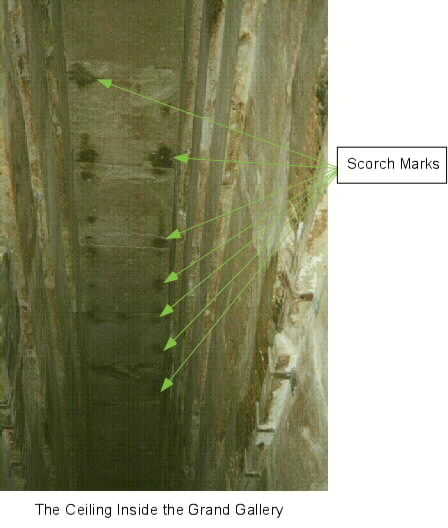
Here’s a link to a patent that indirectly explains the shape and configuration of the Grand Gallery. The inventor, Tim Lucas, discovered that in acoustic systems performing mechanical work, shifting the harmonics of the system’s fundamental frequency upward or downward prevents shockwaves from forming, enabling smoother operation and achieving greater amplitudes. https://patents.google.com/patent/US5515684A/en
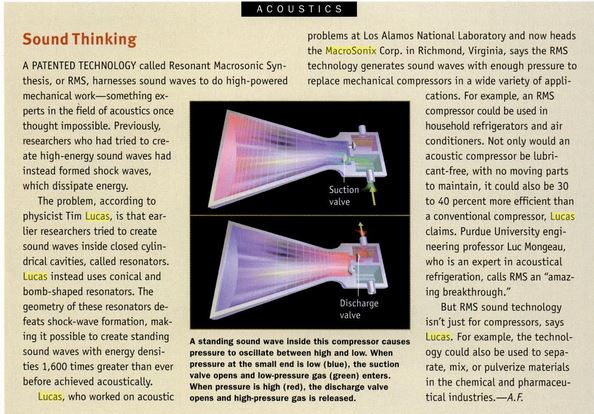
The corbeled walls of the Grand Gallery might not serve solely for structural integrity; they also appear to generate inharmonic frequencies of the fundamental frequencies within the Great Pyramid’s internal chambers. Using the speed of sound in steam, approximately 500 m/s, we can estimate the Grand Gallery’s axial modes for its height, length, and along its eight varied widths. According to Wikipedia, the top of the Grand Gallery measures 1.06 m, while the bottom measures 2.06 m. Acoustically and geometrically, these dimensions roughly span one full scale, encompassing seven notes and one octave. This configuration could ensure that the chamber’s dimensions avoid the harmonic series of the pyramid by remaining within its own inharmonic series, akin to Tim Lucas’s discovery of Resonant Macrosonic Synthesis.
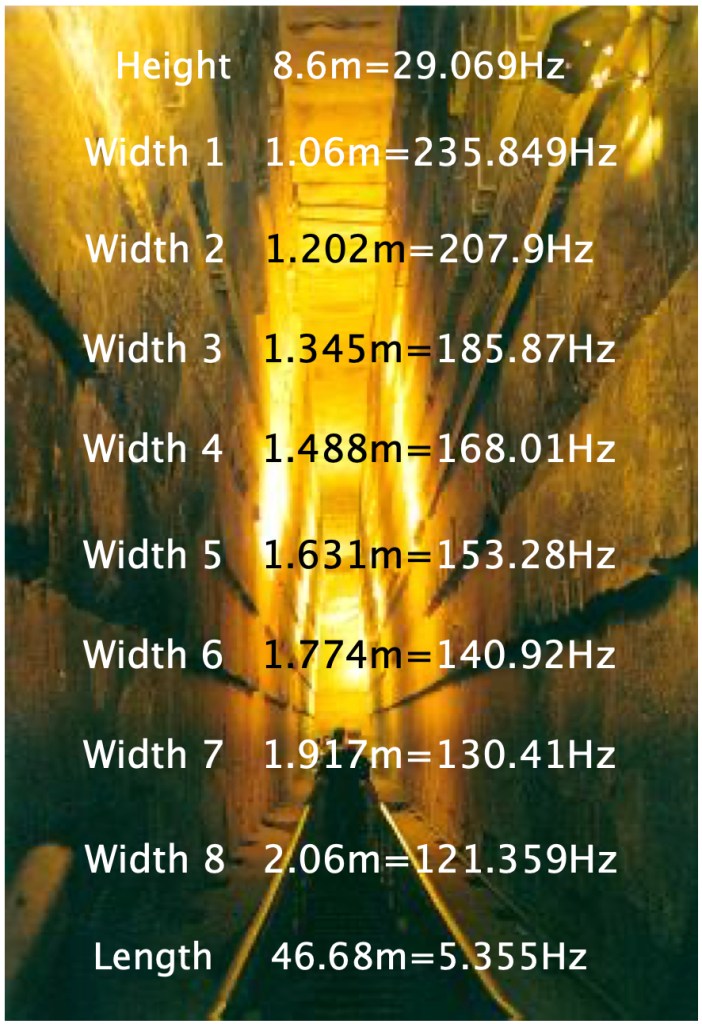
I’ve explored the interior of the Great Pyramid with a private group for over two hours, and while the entire tour group was in the King’s Chamber, I had the Grand Gallery entirely to myself. This gave me the opportunity to create a loud bang on the floor, causing the walls of the Grand Gallery to vibrate. I jumped from the fourth step above the landing, where the stairs meet above the Queen’s Chamber Passage entrance, and landed on the roughly 6-foot by 3-foot floorboards. After the initial impact with the floor, the walls vibrated like the sound of a subwoofer, demonstrating that the chamber resonated freely. The blocks forming the walls actually vibrated for a few seconds after I made the bang, an astonishing experience akin to striking a well-tuned drum. My friends on the tour rushed over, shouting and asking what had happened, as everyone felt a shockwave surge past them. This experience convinced me that the Great Pyramid has a low fundamental frequency; its size, geometries, and materials are all designed for a low-frequency response. Based on the sound and vibration perceived, my ear estimated the frequency at around 45 Hz.
The Antechamber
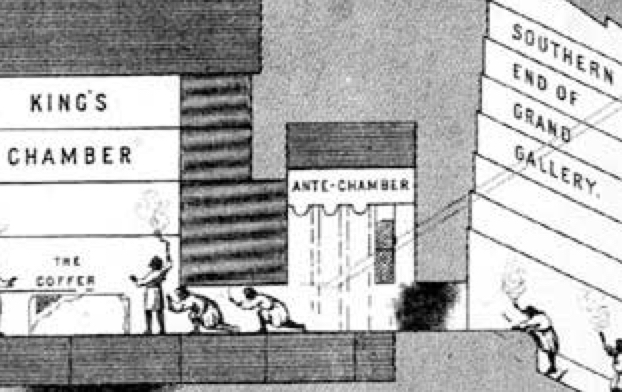
Situated between the King’s Chamber and the Grand Gallery, the Antechamber bears a striking resemblance to a thermoacoustic regenerator, both due to its position approximately one-quarter of the way along the combined length of the King’s Chamber and Grand Gallery and its role as a choke point. Egyptologists have only theorized about the Antechamber’s contents, leaving ample room for speculation. The Khemitians, as the ancient builders may be called, utilized several materials that would be suitable for a thermoacoustic regenerator.
The King’s Chamber
The King’s Chamber of the Great Pyramid consists of approximately 6.5–8 million pounds of red granite, which contains up to 70 percent quartz. The chamber’s dimensions are 10.47 m east to west (length), 5.234 m north to south (width), and 5.852 m floor to ceiling (height). Based on the speed of sound in steam, approximately 500 m/s, the resonant frequencies for the chamber’s dimensions are 42.7 Hz for its height, 47.7 Hz for its width, and 23.9 Hz for its length. These dimensions and frequencies are referenced from http://bigskymap.com. Combining these frequencies yields a 5 Hz beat frequency. This frequency would cause the walls of the King’s Chamber to resonate like a drummer striking a large bell, but the sustain of the chamber’s resonance might actually overshadow the beat frequency, masking it within the chamber’s and the entire pyramid’s resonant response. When you repeatedly strike a large bell, the individual strikes are typically masked by the sustain, so the 5 Hz beat frequency drives the pyramid to resonate—not necessarily at 5 Hz itself. Consider the beat frequency as akin to a medium-paced drum roll. The speed of sound in granite, approximately 5,880 m/s, is significantly higher than in steam, so if the 5 Hz frequency refracts into the granite beams above the King’s Chamber, the sound speed would increase through the granite, resulting in a higher frequency than 5 Hz. At 5,880 m/s in granite, the sound speed increases roughly 11.5 times, yielding a frequency of approximately 57.5 Hz. Please note that these calculations represent only the fundamental modes of the King’s Chamber; many other frequencies are present, but the fundamental modes are the strongest. If the 5 Hz beat frequency serves solely as a driving frequency, functioning like a drummer performing a drum roll, then the beams above the King’s Chamber may resonate at their own resonant frequencies, likely falling within the 200–400 Hz range. The granite beams are 7–8 m long (north to south); thus, 5,880 m/s ÷ 14 m ≈ 429 Hz. The total length of the King’s Chamber ceiling, 10.47 m east to west, plus the approximately 1-meter-thick walls, results in a length of roughly 12.5 m of granite. Therefore, the walls, from east to west, resonate at approximately 5,880 m/s ÷ 25 m ≈ 235 Hz.
All the beams above the King’s Chamber, as well as the blocks composing the chamber, vary in size and rough shape. This variation ensures that no harmonic frequencies are generated between any two different pieces, aligning with the principles outlined in Tim Lucas’s Macrosonic Synthesis Patent.
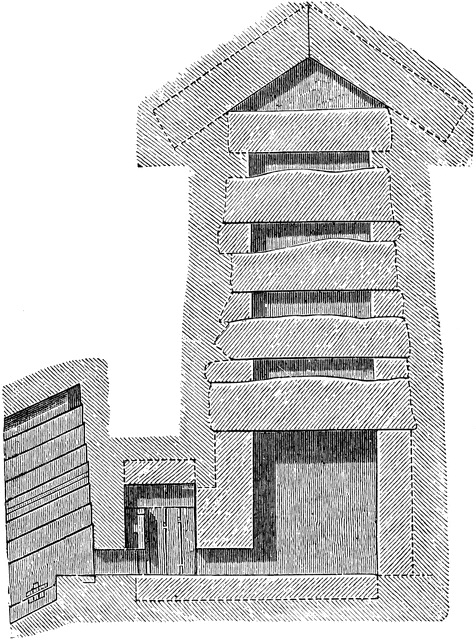
The quartz in the granite is an exceptional piezoelectric material and could potentially generate megawatts of power through the heat and pressures within the system. Through the ingenious use of water hammer, steam, the natural electric charge of the Earth and ionosphere, thermoacoustics, and piezoelectrics, it becomes plausible that the Giza Pyramids generated enormous amounts of power. An intriguing feature of the pyramids is their mass, or thickness. Electrical engineers consider the limestone bulk an insulator, and the thickness/volume of the King’s Chamber granite is typically viewed as merely providing robustness, as electrical charges form only on the surface of conductors. However, the volume of granite, along with the matrix of its constituent materials, might play a significant role in the generation and propagation of a charge. In this context, the bulk of the pyramid could have a far greater influence than electrical engineers currently anticipate, potentially opening the door to a new understanding of how rocks can generate electricity, sound, or radio waves.
Tesla’s Earth Wave Vibration Theory

In the graphic above, Nikola Tesla illustrates his analogy and realization of his Wireless Transmission Theory. The analogy depicts a hand pump inflating a sphere, with gauges responding uniformly around the sphere. In his Analogy Graphic, Tesla explains that each pump pulse is felt with equal force at all points on the sphere, which he describes as a flexible, spherical envelope filled with a liquid or gas. Tesla then demonstrates in the Realization Graphic how the Earth could serve as a medium for distributing electricity wirelessly, applying the principle illustrated in the Analogy Graphic.
There is no “free energy” in this system. Tesla makes no mention of harnessing the Earth’s energy to power the Wardenclyffe Tower. Instead, the tower required a large generating station located adjacent to it. Tesla also sought power from Niagara Falls, which was not far away.
Tesla’s Wardenclyffe Tower contained two resonating coils placed in series with the Earth and a virtual ground terminating the circuit at the top of the tower. The tower operated in a single-phase configuration (single wire, monophase), with a generating station providing the current for transmission. Each of the pyramids, Khafre and Khufu, functions as a resonant conductor, akin to a pair of Tesla coils arranged in a parallel configuration.
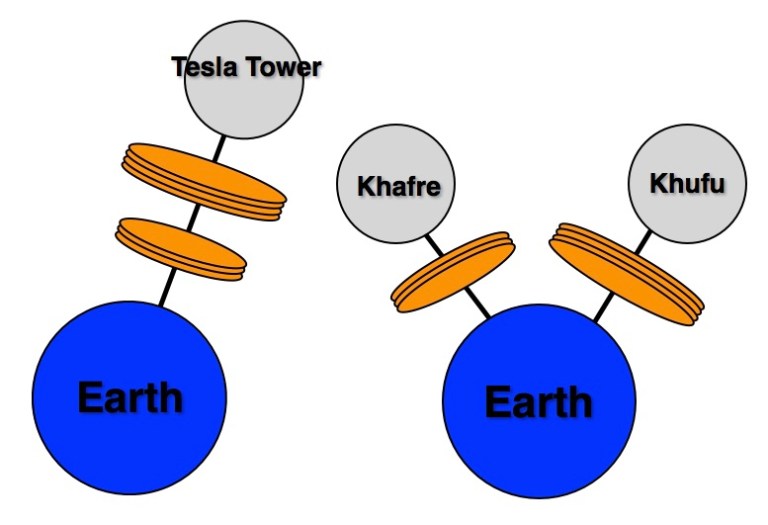
With the two largest Pyramids at Giza working as resonant generators, and both Pyramids fundamental frequencies being induced into the ground in such close proximity, the fundamental frequencies of the Pyramids would clash in a constructive and destructive manner. The frequencies generated would mix and create a beat frequency, or pulsation. The Pyramids seem to be pulsing acoustic and electromagnetic frequencies into the Earth, just the way Tesla simply describes in his Analogy Graphic –Tesla’s Earth Wave Vibration Theory. The pyramids appear to be a series of resonant transformers harmonically balanced to the electrical condition of the Earth. This arrangement could possibly set up a standing acoustic/electromagnetic wave within the Earth and the Ionosphere for the transfer of wireless energy! I was interviewed by Amr Waked, a famous Egyptian actor, for his Youtube series about ancient mysteries. I’m on towards the end, the 11:00 minute mark.
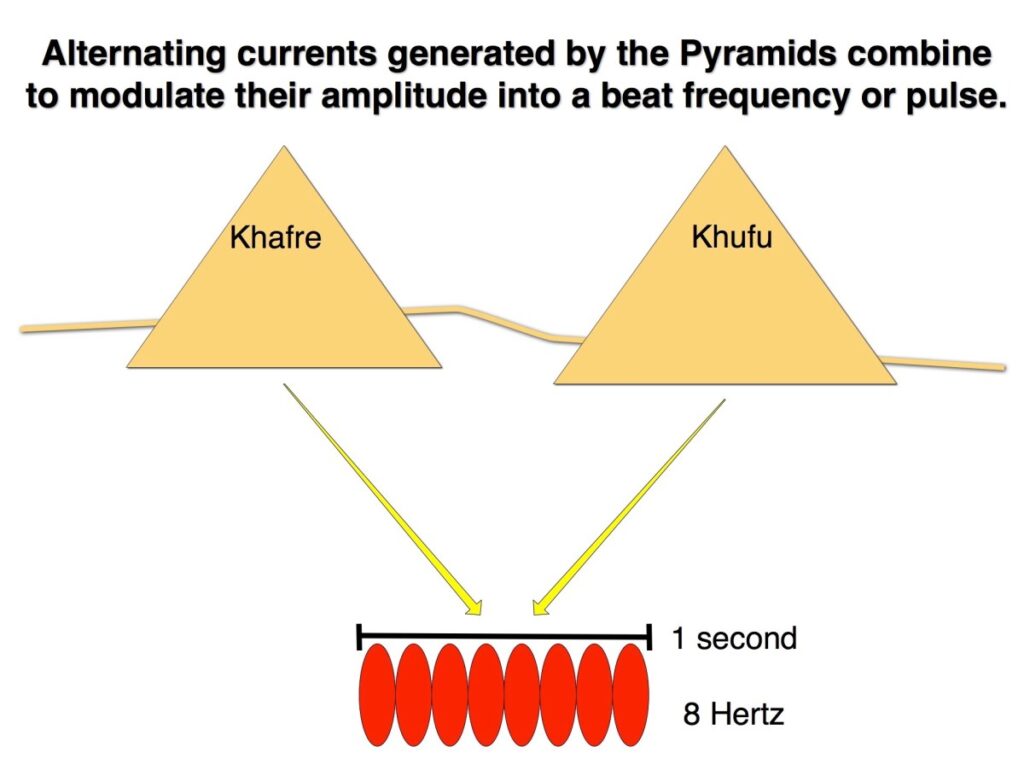

The waveform above demonstrates how the Ancients could have used beat-frequencies to generate low-frequencies. Couple this effect with hitting a resonant frequency of the Earth and you have a resonant switched, resonant amplified signal being transmitted around the globe!!
Electromagnetic modes of the Earth-Ionosphere cavity are the Schumann Resonances. https://en.wikipedia.org/wiki/Schumann_resonances
https://en.wikipedia.org/wiki/Telluric_current
At the speed of sound through the pyramids, using an average P-wave velocity of 6 km/s, Khufu’s Pyramid resonates at approximately 26 Hz, while Khafre’s Pyramid resonates at approximately 28 Hz. This results in a 2 Hz difference, which produces a 1 Hz modulation wave. It’s noteworthy that a low-frequency beat-frequency difference between the pyramids might correspond to a thermoacoustic steam engine within the Great Pyramid, thereby synchronizing the vibrations of the Giza Plateau with the engine inside Khufu’s Pyramid. Recall that the ram pump pulses every 2 seconds; therefore, if the beat frequency of the pyramids 2 Hz, the ram pump likely aligns with every fourth beat generated by the pyramids.
Extremely Low Frequency (ELF) radio waves, ranging from 1 to 30 Hz, travel nearly losslessly through the Earth, with an attenuation of 1–2 decibels per 1,000 km. A radio transmitter operating at these frequencies has the potential to be received worldwide.
Imagine the pyramids slowly pulsing at 1 or 2 Hz. A 1 Hz frequency results in 86,400 pulses per day, equivalent to the total number of seconds in a day. However, a 2 Hz beat frequency reverses phase every other beat, resembling a pendulum swinging back and forth every second. The Earth rotates at 460 meters per second, and the Great Pyramid is 230 m wide, such that 460 ÷ 2 = 230. As the pyramids rotate with the Earth, they pass through space twice every second, potentially allowing them to be synchronized or clocked to the planet. This alignment is fitting, as Earth can be conceptualized as an electric motor spinning at 460 meters per second.
The image below, sourced from a book of Tesla patents at a Tesla Museum in Hungary, depicts Figure 4, which does not appear in any other Tesla patent available online. It appears to illustrate a double-tower version of the Wardenclyffe Tower. The arrangement resembles that of the pyramids, featuring two resonant transformers with slightly different frequencies paired together. Note the length of the vertical coils: the one on the left is longer and would resonate at a lower frequency than the one on the right, analogous to the Khufu and Khafre Pyramids. Tesla originally intended to build two towers at Wardenclyffe, but financial constraints prevented him from realizing his original vision. The specifics of how the twin-tower system would function remain a mystery, though modulation may provide the answer. Tesla coils reportedly perform optimally when the primary and secondary coils have an 8% difference in frequency, suggesting that this principle might have been applied to Tesla’s Wardenclyffe Tower design.
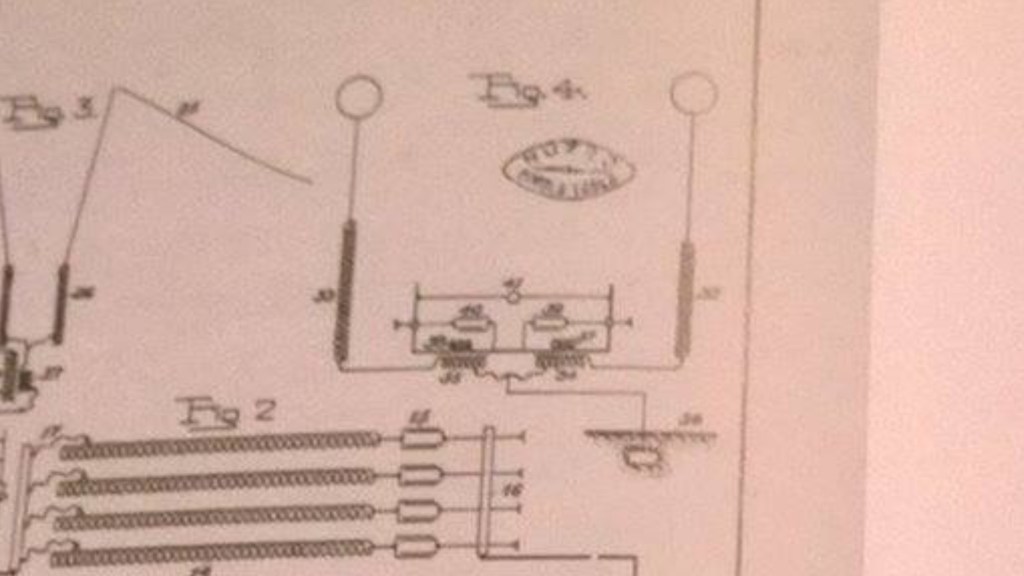
The pharaoh’s name, Sneferu, possibly translates to “double harmony.” Sneferu also constructed two pyramids of different sizes in close proximity to each other—the Red Pyramid and the Bent Pyramid. This suggests that the system employed by the ancients primarily utilized two frequencies harmonizing with the Earth. The Red and Bent Pyramids are located in Dashur, 21 km south of the Giza Pyramids. Why would the ancients build their structures so similarly if there were no overarching master plan? If the pyramids functioned as resonators, the frequencies they generated would combine into the sum and difference of those frequencies, resulting in beats. The Giza Pyramids and the Red and Bent Pyramids may also have been coupled, modulating in a similar manner. For instance, if you place a subwoofer on the floor of a room and increase its volume, you can walk around and find the spot where the subwoofer’s frequencies are loudest; this could indicate the relative positioning of Khafre’s Pyramid in relation to the Great Pyramid, and of the Bent Pyramid in relation to the Red Pyramid.
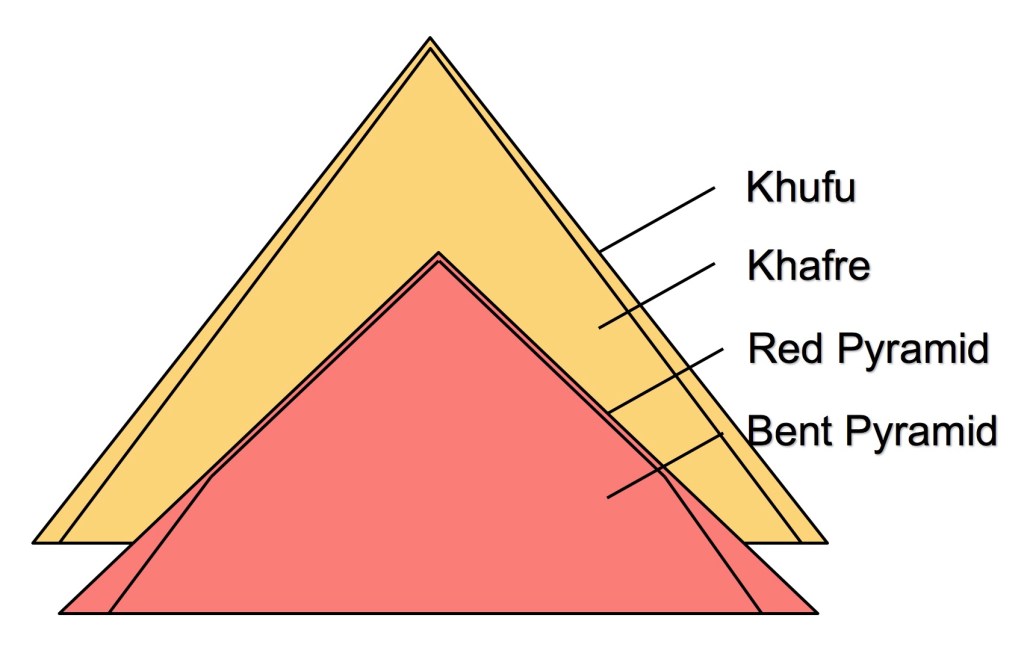
The combined volumes of the Pyramids of Giza, excluding the Great Pyramid, total approximately 99.5% of the Great Pyramid’s volume, and possibly even closer. This fact is particularly intriguing because cubic volume and frequency are intrinsically linked. The missing volume might suggest the existence of a missing satellite pyramid on the Giza Plateau, or perhaps some of the Queens’ Pyramids were slightly larger than Egyptologists currently estimate as only their “unfinished” cores remain.
Khufu G1 – 2,592,401m3
Khafre G2 – 2,216,241m3
Menkaure G3 – 235,183m3
Khufu G1A – 24,707m3
Khufu G1B – 25,000m3
Khufu G1C – 21,105m3
Khufu G1D – 2,176m3
Khafre G2A – 3,125m3
Menkaure G3A – 18,327m3
Menkaure G3B – 6,897m3 (likely similar to G3A)
Menkaure G3C – 6,897m3 (likely similar to G3A)
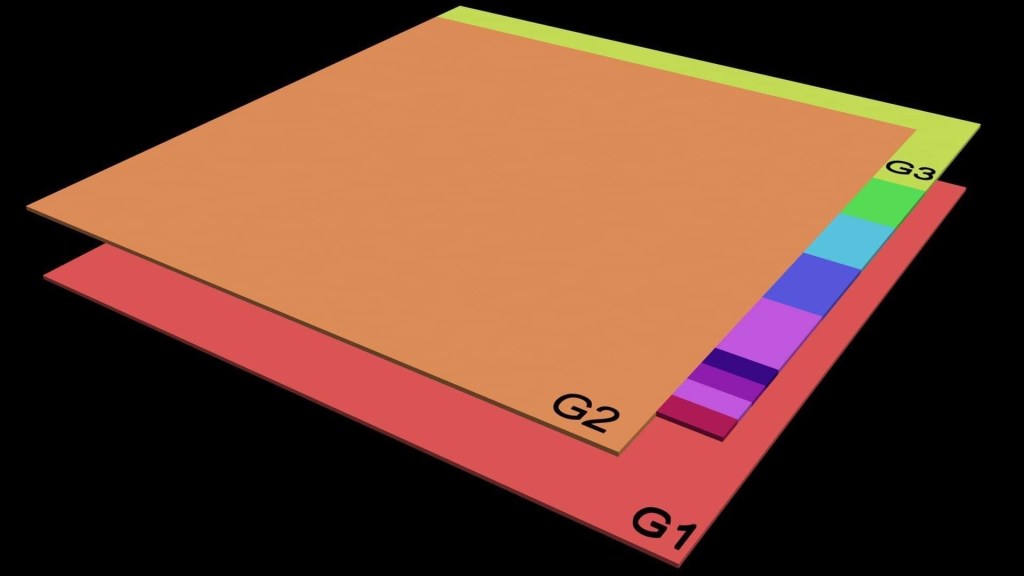
Total Pyramids volume less G1 = 2,559,358m3 = 98.7% The volume of G1. These volumes may be even closer, for G3B and G3A could be larger as only their cores remain, pushing the number to 99.5% or greater. This volumetric discovery might be what proves that there was a unified plan at Giza.
Below is a picture illustrating the electromagnetic resonant frequencies of the Giza Pyramids based on the latest Electromagnetic Survey of the Great Pyramid. Take the speed of light and divide it by the Base width of a pyramid and you’ll get the electromagnetic resonant frequency of that pyramid. Khufu’s Pyramid’s resonant frequency clocks in at a 230m wavelength, or 1.304mhz, and Khafre’s Pyramid’s resonant frequency comes in at a 215m wavelength, or 1.395mhz.
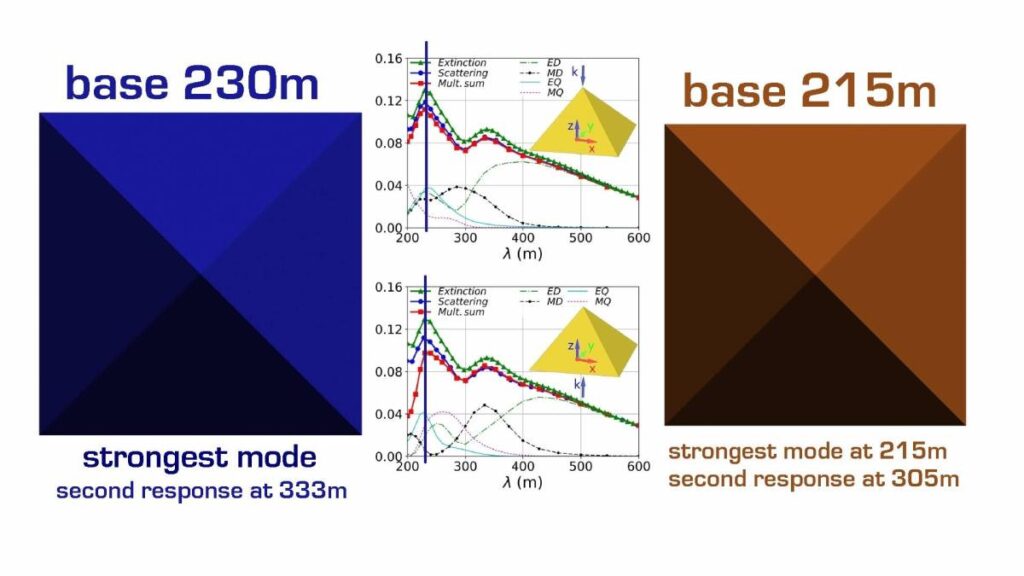
Here’s a link to the Electromagnetic Survey Publication. Mikhail Balezin et al, Electromagnetic properties of the Great Pyramid: First multipole resonances and energy concentration, Journal of Applied Physics (2018). https://aip.scitation.org/doi/10.1063/1.5026556
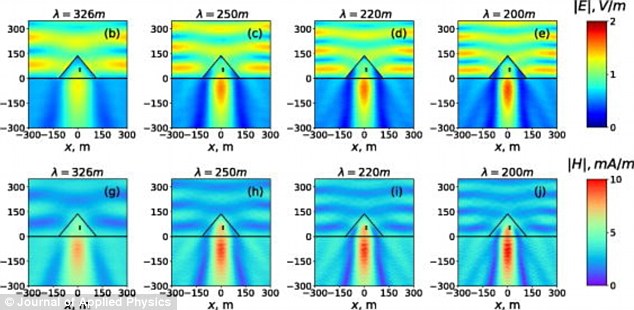
Tesla originally attempted to use a pulsation at 50 kHz (corresponding to a 6 km wavelength). The pyramids appear to operate within a similar low-frequency range in radio terms. They seemingly mix frequencies of 1.304 MHz with 1.395 MHz, modulating at 91 kHz, or a 3.3 km wavelength, which also corresponds to a 45.5 kHz wave with a 6.6 km wavelength. This is strikingly similar to Tesla’s method of using a high-frequency signal pulsated at a lower frequency. Intriguingly, Tesla claimed to utilize longitudinal transmission through the Earth, and the pyramids also appear to do so, outputting low-frequency acoustic waves through the Earth in a beat-frequency pattern. While the acoustic frequencies emitted by the pyramids into the Earth would undoubtedly cause modulation, it’s unclear whether the electromagnetic frequencies would modulate similarly. The pyramids are directly coupled through the ground and are closely positioned if they indeed function as transmitters, which should cause interference; however, the electromagnetic frequencies might collaborate to broaden the frequency band the ancient builders were targeting. The electromagnetic waves emitted by the pyramids would likely modulate in the ionosphere, and if the ionosphere is coupled to the Earth—and vice versa—I believe it’s entirely possible that the pyramids interacted with each other, both constructively and destructively.
http://onetuberadio.com/2015/02/26/the-luxembourg-
Read about Tesla’s Wardenclyffe Tower here. https://en.wikipedia.org/wiki/Wardenclyffe_Tower
Watch a demonstration on how Tesla’s Wardenclyffe Tower might’ve functioned here:
Tesla Coil Wireless Energy and Resonance Demonstration
Here’s a good article on how Tesla may have incorporated acoustics into the Wardenclyffe Tower for modulating the output signal into a longitudinal wave. https://teslauniverse.com/nikola-tesla/articles/tesla-longitudinal-wave
The apex of a pyramid is the ideal shape to facilitate electrical discharges in and out of a virtual ground. If the tips of the pyramids were gold-plated, this would strengthen the parallels with the Wardenclyffe Tower. Gold is an excellent conductor and resists corrosion, ensuring it remains a stable ground. The pyramid’s shape naturally channels current outward from the tip, and with the pyramids negatively charged and the ionosphere positively charged, we have the optimal configuration for ion/electron flow.
One potential way the pyramids could generate an electric signal is through the electro-acoustic phenomenon of a streaming vibration current, which occurs when a sound wave propagates through a porous medium with fluid-filled pores. Limestone is porous, and the pyramids likely sat in water while being subjected to acoustic hammering. In this scenario, the pyramids would function as electrokinetic transducers. https://en.m.wikipedia.org/wiki/Streaming_vibration_current
Friedemann Freund has determined that a charge through granite propagates at 100-200m/s. Interestingly, many pyramids in Egypt fall into the size range of 100-200 meters. The Giza Pyramids appear to have been pulsing at 1-2Hz while also falling into this size range. Maybe pyramid dimensions reflect the time it takes a charge to make its way through or across the structure and be emitted. Khufu’s and Khafre’s Pyramids are 146 and 143 meters tall and 230 and 215 meters wide respectively.
Here’s a link to the “Time Resolved Study of Charge Generation and Propagation in Igneous Rocks” By Friedemann Freund. https://agupubs.onlinelibrary.wiley.com/doi/pdf/10.1029/1999JB900423
Here’s a presentation by Friendemann describing his experiment with generating a charge in igneous rock, as well as what electric effects could be generated on a global scale.
In Friedeman’s experiment, he applied 60,000lbs of force on what appears to be a 6-8″ square piece of granite that was 4m long, and generated 1000 Pico-amps. The stressed portion of the granite was roughly 6” cubed and would’ve weighed around 20lbs. By this logic, the amount of granite in the Great Pyramid, roughly 6,600,000lbs, would generate less than 1 amp of current, at a speed of 100-200 meters per second, and under static pressure.
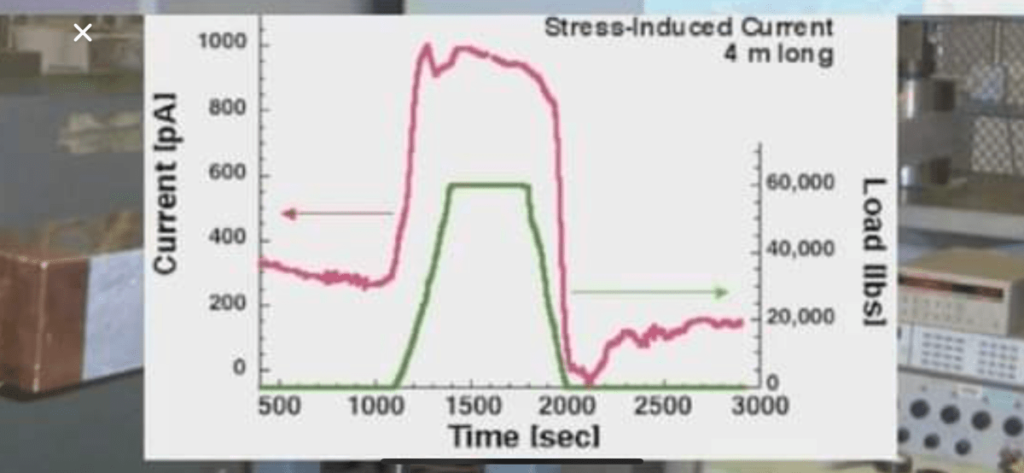
Piezoelectricity on the other hand, produces intense voltages which can be utilized to generate an extremely powerful radio signal, but not an electric current.
Pyramid Power Uses
If the Pyramids were in fact like big Tesla Coils, then the output effects could be acoustic, electric, magnetic, radio and light, and it’s possible that different Pyramids utilized different effects that were generated.
Earthquake Lights
https://en.wikipedia.org/wiki/Earthquake_light
People often mistake UFOs for earthquake lights. UFO sightings and earthquakes are closely related, as reports of “UFOs” frequently surge during seismic activity. Electrical discharges originating deep within the Earth are responsible for these luminous phenomena. It’s also noteworthy that many UFO sightings reportedly occur near ancient monuments. Earthquake lights can even manifest as auroras.


Piezoluminescense
One of the interesting effects of quartz crystals is that they can emit light through an effect known as piezoluminescense. This effect can arise in the KHz to MHz range, with brightness attributed to power.
Quartz crystals EXPLODING with LIGHT (Triboluminescence / Blackbody Radiation)
https://en.m.wikipedia.org/wiki/Piezoluminescence
Thermoluminescence
Rocks can emit light after being after being exposed to high energy radiation.
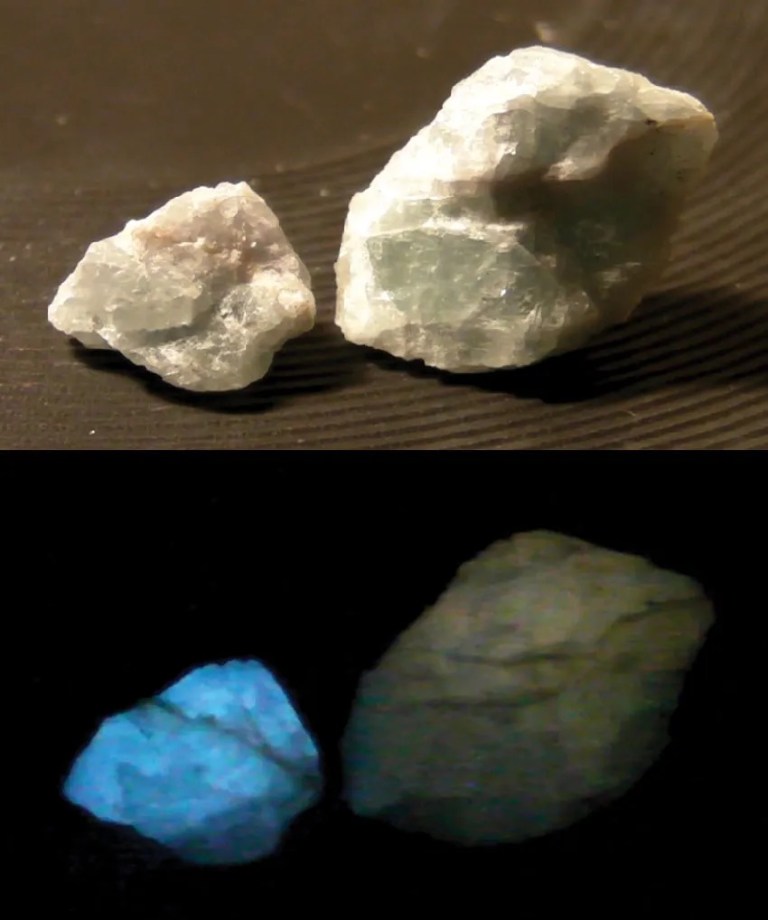
https://www.capturedlightning.com/frames/SpecialLichs.html
https://www.britannica.com/science/thermoluminescence
https://www.oxfordauthentication.com/about-us/thermoluminescence-tl-testing-process
Electroluminescence
https://www.britannica.com/science/electroluminescence
Phosphorescence
https://en.wikipedia.org/wiki/Phosphorescence
Ultrasonics
Any electromagnetic frequencies generated within the pyramids might produce an ultrasonic output of a similar frequency, as the piezoelectric effect is reversible. All the holes around the Giza Plateau extend down to the water table; therefore, if the pyramids generated ultrasound, these holes would release mist from the groundwater. Mexico’s pyramids are also constructed above underground rivers and water holes, suggesting this concept may apply to pyramids worldwide. The electromagnetic frequencies of the Giza Pyramids, specifically 1.304 MHz for Khufu’s Pyramid, 1.395 MHz for Khafre’s Pyramid, and 2.8MHz for Menkaure’s Pyramid, fall within the range of frequencies used in ultrasonic humidifiers. The wavelengths of these MHz frequencies at the speed of sound through the structures, 6Km/s, is 4.6mm for 1.304 MHz, 4.3mm for 1.395 MHz, and 2.15mm for 2.8MHz. These wavelengths align with the average crystal size found in granite, which ranges from 1 mm to 1 cm. If the pyramids modulate these ultrasonic frequencies into a beat frequency of 91 kHz, this frequency coincides with one used in ultrasonic cleaners, as it effectively agitates the water with tiny implosions. Employing two high frequencies modulated into a lower frequency for simultaneous vaporization and agitation of water appears to be a highly efficient use of ultrasound. Ultrasonic effects would have a short range and be localized to the pyramids. If this hypothetical pyramid effect is valid, salt should be found at the base of the shafts around the plateau.
The pyramids were likely constructed 500 years before Khufu, when the desert had not yet fully overtaken the region. Perhaps the pyramids were built to induce rainfall in the Sahara Desert, thereby preventing the desertification of ancient Khemit. The northwest winds of Egypt could carry the mist far across the desert. This may explain another reason for the pyramids’ location: to leverage prevailing winds to disperse mist over the desert. It has also been theorized that some pyramids could have been used to produce chemicals like nitrogen and ammonia, suggesting the possibility that the pyramids were designed to vaporize nutrient-rich water for irrigating the desert and fostering plant life. Interestingly, Tesla and his contemporaries during that era contemplated similar concepts, envisioning the use of electricity to modify weather patterns and generate fertilizers.
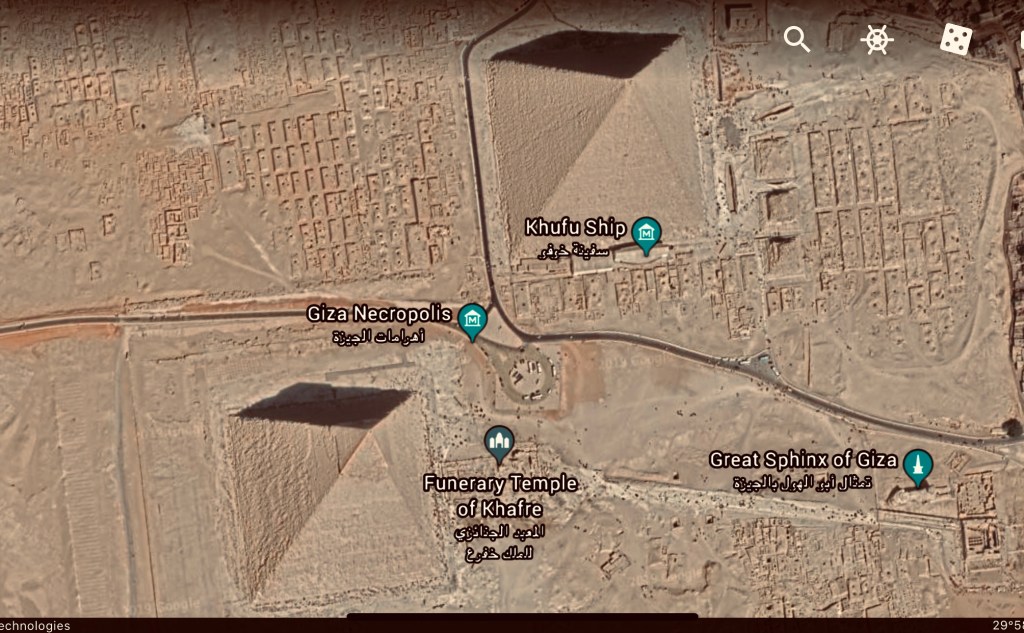
Arc Light/Ozone Generator
If the Giza Pyramids generated a constant, extremely powerful arc on the order of 1.5 billion volts, it would produce a tremendous amount of ozone, accompanied by a bright bluish-purple light. Ozone has purifying properties and is beneficial for the atmosphere.
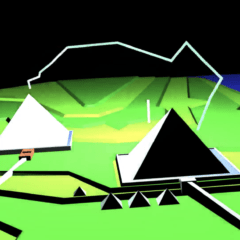
Artificial Auroras
The most recent experiment with HAARP to generate an artificial aurora was unsuccessful, primarily due to weather conditions, but the researchers used frequencies of 2.8 MHz, 2.82 MHz, and 2.84 MHz. These frequencies align with the Pyramid of Menkaure’s electromagnetic resonant frequency (roughly the 107-meter band) and are approximately twice the electromagnetic frequencies of Khufu’s and Khafre’s Pyramids (215–230 m band). [See: https://www.google.com/amp/s/spectrum.ieee.org/tech-talk/telecom/wireless/scientists-in-alaska-attempt-to-produce-fake-aurora-with-giant-antenna-array.amp.html.]
Nikola Tesla not only claimed that the powerful transmitter he built at Wardenclyffe would create a bright aurora in the night sky, but it also happens that the power and frequencies generated by the Great Pyramid fall within the same power and frequency range as those of current ionospheric research facilities worldwide. Ionospheric heaters operate in the range of 3–30 MHz, with power outputs ranging from 750 kilowatts to 3.6 megawatts—roughly the amount needed to have a noticeable effect on the ionosphere. For example, HAARP transmits at 3.6 megawatts. The Great Pyramid, operating continuously without internal combustion or detonation, could output 2 megawatts at 10% efficiency and 20 MW at 100% efficiency. If the ancient Khemitians had 130 extremely powerful pyramid radio transmitters spanning roughly 75 km, they might have observed a faint airglow at night and possibly even a serpent-like figure in the sky, as many ancient cultures revered. Perhaps these lights in the sky represented the spirit world, or the Aether. If the pyramids operated in the gigawatt range, I believe bright artificial auroras would have occurred, not merely a faint airglow. The pyramids could potentially be the most powerful radio transmitters ever constructed.
The electromagnetic frequencies of the King’s Chamber are:
- Axial width: 14.3 MHz
- Axial length: 28.6 MHz
- Axial height: 25.6 MHz
- Tangential: 32 MHz
- Oblique: 41 MHz
- Pyramid itself: 1.3 MHz
Mythologically speaking, the pharaoh’s soul was believed to ascend daily and return nightly, with the Great Pyramid serving as the gateway connecting Heaven and Earth for the ascension of the pharaoh’s soul—and those of their companions—into the afterlife. The pyramids might actually function as “resurrection machines,” a concept long contemplated by many Egyptologists and scientists. The ancient Egyptians believed in an Ether, or spirit realm, so it’s not far-fetched to consider that the most religious civilization in history invested such immense effort and resources to ensure their transition into the afterlife, mythologically speaking. I believe there’s a strong possibility that the ancient Khemitians (Egyptians) were far more advanced than traditional Egyptologists and archaeologists acknowledge. Below is an image of a “Picket Fence Aurora,” which appears to display a pattern of constructive and destructive interference—possibly interpreted by the ancients as a line of dancing souls. Auroras typically generate radio signals in the 2–200 kHz range, and the Giza Pyramids appear to modulate at 91 kHz.


The Electromagnetic waves emitted by the Pyramids would modulate in the Ionosphere. http://onetuberadio.com/2015/02/26/the-luxembourg-
effect/https://en.wikipedia.org/wiki/Luxemburg–Gorky_effect
Geissler Tubes
Geissler tubes would have been within the technical capabilities of the ancient builders and could have provided illumination in areas where torches were insufficient. When brought near a high-voltage source, a Geissler tube will luminesce.

OLYMPUS DIGITAL CAMERA
https://en.wikipedia.org/wiki/Geissler_tube
https://www.crtsite.com/page6.html
The pyramids would have been exceptionally bright during the day, as they were covered in highly polished white limestone. The total solar power striking a pyramid can be calculated by multiplying the surface area of its base in square meters by 1,356 watts per square meter (total solar irradiance per square meter), then dividing that total by the pyramid’s total surface area, excluding the base. These figures represent the amount of light and energy striking the pyramids at high noon.
The Great Pyramid receives approximately 25 watts per square meter more solar power than the Khafre Pyramid, while the Menkaure Pyramid receives approximately 25 watts per square meter more than the Khufu Pyramid.
G1 (Great Pyramid): 839.665 W/m²
G2 (Khafre Pyramid): 815.08 W/m²
G3 (Menkaure Pyramid): 864.63 W/m²
If you observed the Great Pyramid from one of its cardinal points around high noon, and the great pyramid only reflected 5% of the Sun’s energy, it would have been roughly equivalent to a 900,000watt light bulb in brightness. The Great Pyramid’s slight concavity and shiny white surface would have reflected and focused this energy, resulting in remarkable brightness.
Surface areas of the Giza Pyramids:
G1 (Great Pyramid): 85,745 m²
G2 (Khafre Pyramid): 77,185 m²
G3 (Menkaure Pyramid): 18,360 m²
No aliens, no religion, no magic—the pyramids focus their energy down the middle. The word “pyramid” can be translated as “fire in the middle.” The name for the Great Pyramid, Akhet Khufu, can be interpreted as “Khufu’s Mountain of Light.” Similarly, the name for an obelisk can be understood as “To the Beat of a Drum.” Perhaps pyramids worldwide are capable of harnessing an effect that we have yet to recognize. It could involve generating artificial auroras, inducing rainfall, serving as an earthquake or tsunami warning system, or functioning as an ancient form of communication. Whatever this effect turns out to be, it will likely be a tangible, verifiable phenomenon. For now, pyramids remain known as temples and tombs, but that perception may not hold for long.
* Both Chris Dunn and Eric Wilson should be ashamed of themselves for not referencing teslapyramds.com in their work. Teslapyramids.com is where the first continuous running motor attached to John Cadman’s ram pump was ever published. The info presented on this site has taken countless hours of research and thought and has developed considerably over time. I have a pretty long history with Chris and Eric, which will be interesting to share when the time is right. Eric’s even given me credit for “helping with these discoveries” in a podcast. It’s pathetic of them to not reference the work presented on this website. *
In this podcast, Eric Wilson gives me credit at 1Hr:32mins. Before that, he’s spouting a lot of B.S. Eric knew of Teslapyramids and thus thermoacoustics in the Great Pyramid before ever going to Egypt. This website was published in late 2016 and I had sponsored a Link on Facebook in early Jan 2017. The sponsored Link cost me almost 5k Canadian and it reached 250k people. Both Eric and Chris predominantly use Facebook and this is how we met. Dunn even tagged Eric and I personally on his Facebook page inviting us to go to Egypt with him on a tour. I wonder how different things would be if I went on that tour, I had just become a dad and was in the middle of buying a house. Chris ended up blocking me for finally criticizing him, and questioning him about Eric’s legitimacy, as Eric seemed to parrot everything I was saying at the time. Eric even called me from Egypt on his second tour and told me that he could read my mind and that we were connected, which is an extremely weird thing to say. In the end though, Chris’s new book offers nothing new, it’s frankly other people’s research just cobbled together with his older theories rehashed into the mix, so good riddance.
Email: teslapyramids@gmail.com
PS, the Great Pyramid was built with geopolymers. http://Geopolymer.org
Cheers!!
Danny,
Tesla Pyramids